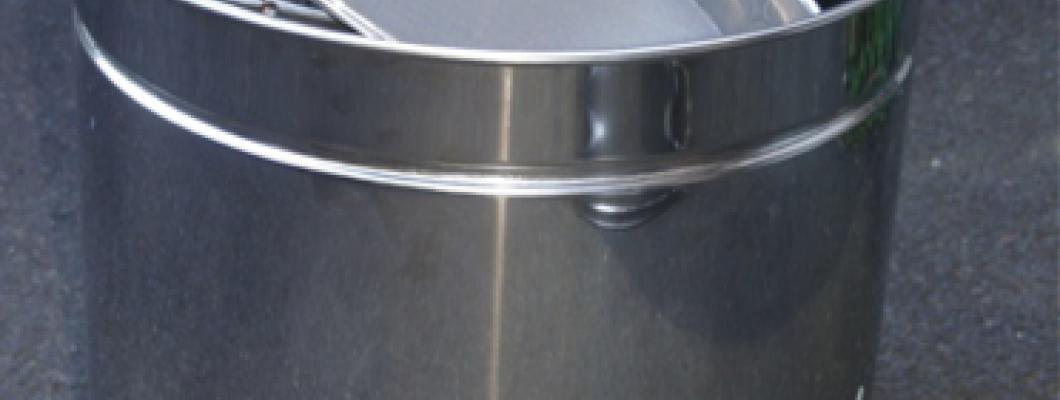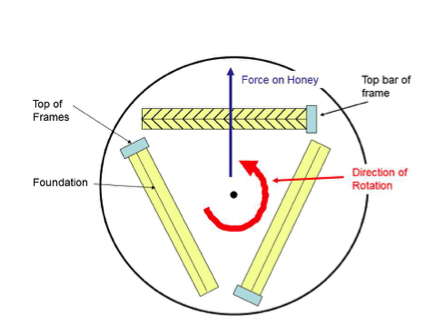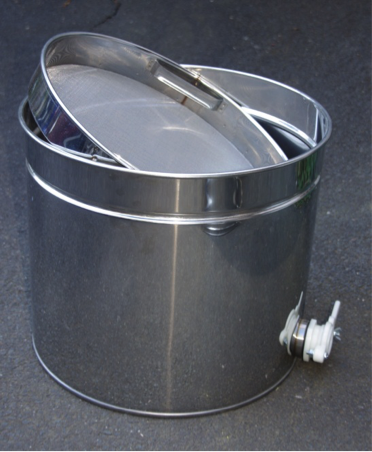
The first extraction for a new beekeeper is always both exciting and daunting, exciting because all the hard work up until then has finally come to fruition. Daunting since extraction appears to be a difficult task, which it is not, and comes with some concern about how much honey will be extracted. My experience with new beekeepers is that they totally underestimate how much honey a hive will produce, usually about 25kg to 30kg per extraction per hive, with about two or three extractions per season. Thus, the average hive will provide about 70kgs to 90kgs per season to the beekeeper and often a lot more, this is a lot of honey!
UNCAPING THE FRAMES:
Holding a capped frame over an uncapping bucket as shown in Figure 1, use a scratcher to score or break up the capping. Once the surface has been broken up, repeat the process on the other side of the frame. The frame should now be placed inside the extractor. Repeat the process on other frames until the extractor is full of uncapped frames. A scratcher, although easy and flexible to use, has the disadvantage that it produces a lot of fine wax particles that will soon block the sieve, resulting in a sieve that needs to be cleaned frequently during the extracting process.
An alternative to a scratcher
is to use a long knife to cut off the capping as shown in Figure 2. The frame is rested on the screw and, with a
downward motion, slices the capping off the comb. Using a knife is slightly more difficult than
using a scratcher, but has the advantage of peeling off the capping in a single
sheet that does not block the filter with wax.
A simple extracting knife is inexpensive but may need to be heated in hot water before use. Many beekeepers use two knives, one of which is being heated in hot water while the other is being used to cut the capping. When the knife being used cools down, it is placed in the hot water and the other knife removed and used. On hot days, when I do most of my extracting, I have used a knife without heating t since I find the wax is sufficiently warm and pliable to be cut without a heated knife. See Figure 3.
A more convenient method is to purchase an electrically heated knife that will more easily cut through the wax capping, see Figure 4. Electric knives have a heating element inside the blade and will remain at a suitable temperature during uncapping. Steam knives used to be popular and are available at most beekeeping supply shops. These knives are cheaper than electric knives but have the major disadvantage that they require a water boiler, which the beekeeping supply store will not provide. Steam knives are also more cumbersome to use since there is a pair of hoses connected to the knife, the first to provide steam to heat the knife, the second to remove the steam away from the beekeeper. Really, although some beekeepers would prefer to use a steam knife if they could get hold of all the pieces, making a steam boiler requires good plumbing skills and can be made out of an old pressure cooker.

USING THE EXTRACTOR:
Once the capping has been scored or removed, it is time to place the frames into an extractor to remove the honey. The frames need to be inserted as shown in Figure 5, taking into account the direction of rotation of the cage. This is because comb cells point slightly downwards towards the back, and if the frame was rotated in the wrong direction the honey would collect in the bottom of the cell and not flow out of the cell. See Figures 3 and 8 for the correct way to insert a frame into an extractor.
As a general rule, when determining the number of turns that the frame should be rotated the 75-150-75 rule applies. First, rotate one side of the frame 75 turns to remove ½ of the honey from that side. Turn over the frame and rotate this side for 150 turns to remove all of the honey from this side. Now rotate the frame back to its initial position and rotate a further 75 turns. This process is used because if you start off by rotating the first side by 150 turns the weight of honey on the inside may push its way through the foundation breaking the honey comb, resulting in a lot of extra work for the beekeeper to repair the frame.
FILTERING THE HONEY:
Some extractors have a built in filter and holding tank as shown in Figures 6, 7 and 8. If you only have a small number of hives these are the most convenient to use since the honey is extracted ready filtered and ready to eat.

Many extractors do not have a built in filter and instead the extracted honey, containing a lot of wax, pours out of a gate at the bottom of the extractor, see Figure 9. In order to filter the honey a pail with a filter resting on top is placed under the gate and the honey pours into it as it is extracted. This type of extractor would be convenient for a beekeepers with about 6 or more hives.
CLEANING UP:
At this time, when the empty
frame is removed from the extractor it is covered in honey and is called a sticky.
The best way to clean a sticky is to place it back inside the hive where
the bees will clean it overnight, leaving a spotless frame with clean comb that
can either be left inside the hive or removed for storage.
If you only have one or two
frames of capped honey and do not plan to extract for some time, to store the
frames wrap them in a large garbage bag, seal the bag with thick tape, place
the frames in the freezer for 2 days to kill any wax moth larvae or beetles,
and then store the frames, still in their garbage bags, inside a plastic bin
until you are ready to extract. This is
also a good technique when reducing the number of supers on a hive ready for
winter. Remove the ½ full frames and
prepare them for storage using the above process. When spring comes and you need to add a
super, the half full frames can be removed from their bags and placed in the
hive. Also, if during the winter the
bees have eaten most of their honey, these ½ full frames can be swapped with
empty frames in the hive to provide additional food to the bees.

